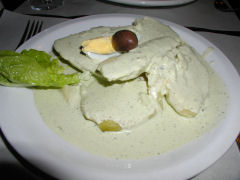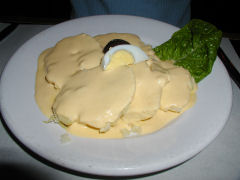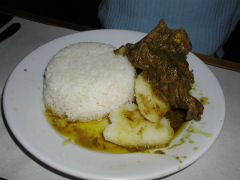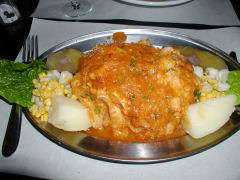Buenos Aires – We were in the mood for Peruvian food once again. Well, basically, except for occasionally talking him into going to somewhere novel, like the Korean restaurant, Henry only likes to eat at Peruvian venues. Other than that, I cook. So it was back to Status, where we had lunch one of the first days I was here. But we did agree in advance on trying some new dishes.
 First, Ocopa, a slightly chilled dish of sliced potatoes topped with a cream sauce made with evaporated milk, fresh farmer’s cheese, herbs, garlic, and slightly spicy yellow peppers. Okay, this is just plain yummy potatoes! We not only gobbled up every last bit of potato, but then sopped up the copious amount of sauce with bread, rice, and more potatoes.
First, Ocopa, a slightly chilled dish of sliced potatoes topped with a cream sauce made with evaporated milk, fresh farmer’s cheese, herbs, garlic, and slightly spicy yellow peppers. Okay, this is just plain yummy potatoes! We not only gobbled up every last bit of potato, but then sopped up the copious amount of sauce with bread, rice, and more potatoes.
We also tried another potato dish (potatoes are quite big in Andean cuisine, and really, throughout South America), Papas a la Huancaina  (from the Huancayo area of Peru – Huancayo is the capital of the province of Junin, and is the commercial and cultural center of the central Andes). Once again based on a creamy cheese sauce, but this time flavored with lemon and a touch of mustard and turmeric, and then some paprika, resulting in a fairly vivid orange-peach color. Much subtler, this was still quite delicious. The sauce also apparently contains crushed crackers of some sort, ground to a fine powder, I’ve seen recipes that listed everything from water crackers to saltines to graham crackers!
(from the Huancayo area of Peru – Huancayo is the capital of the province of Junin, and is the commercial and cultural center of the central Andes). Once again based on a creamy cheese sauce, but this time flavored with lemon and a touch of mustard and turmeric, and then some paprika, resulting in a fairly vivid orange-peach color. Much subtler, this was still quite delicious. The sauce also apparently contains crushed crackers of some sort, ground to a fine powder, I’ve seen recipes that listed everything from water crackers to saltines to graham crackers!
 For our main courses, a Seco de Cordero, or dry-marinated lamb, was the first choice. The lamb is marinated, as best I can tell, in garlic, peppers, herbs, and a sort of paste made from fermented corn (chichas de jora). It is then slow cooked in oil and served with rice. It’s really quite good, though I think it could have been slow braised a bit longer, and probably at a lower temperature to give a more fork-tender texture.
For our main courses, a Seco de Cordero, or dry-marinated lamb, was the first choice. The lamb is marinated, as best I can tell, in garlic, peppers, herbs, and a sort of paste made from fermented corn (chichas de jora). It is then slow cooked in oil and served with rice. It’s really quite good, though I think it could have been slow braised a bit longer, and probably at a lower temperature to give a more fork-tender texture.
 The second main course was a Tiradito de Pescado, one of my personal favorite Peruvian dishes from past experience. Unfortunately, Status’ version doesn’t live up to past experience. By definition, recipe, and even Status’ menu, this should be chilled strips of fish that have been cured, ceviche style, in citrus juice, then topped with a sauce made from cream and rocoto peppers. This version seemed to be missing the cream, despite the menu description, and was served in a very vinegary sauce that had more of what appeared to be dried pepper flakes in it, and not particularly spicy. The best things on the plate were the potatoes and batatas, with which we sopped up our remaining Ocopa sauce.
The second main course was a Tiradito de Pescado, one of my personal favorite Peruvian dishes from past experience. Unfortunately, Status’ version doesn’t live up to past experience. By definition, recipe, and even Status’ menu, this should be chilled strips of fish that have been cured, ceviche style, in citrus juice, then topped with a sauce made from cream and rocoto peppers. This version seemed to be missing the cream, despite the menu description, and was served in a very vinegary sauce that had more of what appeared to be dried pepper flakes in it, and not particularly spicy. The best things on the plate were the potatoes and batatas, with which we sopped up our remaining Ocopa sauce.
I still recommend this place for a fun exploration of Peruvian food!
[…] Huacatay is referred to by some as Amazon Black Mint, and it has a pungent aroma, sort of a like spearmint; and others insist that it is a variety of the Mexican herb epazote – it doesn’t look at all like the epazote I used to get in New York at the Mexican markets, which had longer, arrowhead shaped jagged leaves, and it has a much more intense flavor. Other names for this are Chiquilla, Chinchilla, and Zuico. I’ve seen both the scientific name Tagetes minuta, and also Pazote chenopodium ambrosioides, which between them come back to a variety of different English names, including muster John Henry, Stinking Roger, Mexican Marigold, Hedionda Grass, Sagrada Grass, and Tall Khaki Weed. Searching for various photos online, some of these look the similar, some don’t. Such is the world of plant names, however I’m leaning more towards the non-epazote camp and something in the mint-ish world. It is a common ingredient in Peruvian cooking especially, and is the key herb in both ají de huacatay (not surprising), a spicy hot sauce from the Arequipa area, and in the sauce for ocopa, one of my favorite potato dishes. […]
[…] A few weeks ago one of our local food writers reviewed a new Japanese restaurant located just off the main strip in Barrio Chino. One of the assertions made was “Para empezar debo decir que probé las gyosas mejores de mi vida, sin exagerar.”, or, “To start I have to say that I tried the best gyozas in my life, without exaggeration.” At a later juncture, she also asserts that some of the sushi tried is, in essence, invented on site and not available anywhere else (an example given is salmon with mango and avocado, available from almost any sushi bar here I can think of). On the other hand, this same columnist recently wrote up one of our favorite Peruvian restaurants, Zadvarie, claiming that it is the only place in town offering ocopa arequipeña because they have the only source of huacatay herb in town through a store in Barrio Chino. We eat the dish regularly at other restaurants (and it’s better at some and not as good at others), and as regular readers here know, I buy huacatay in the markets in Liniers by the bagful for mere pesos. […]
[…] giblets done up anticucho style in a spicy red pepper sauce, and accompanied by easily the best ocopa we’ve encountered here in a […]
[…] the 35 minute mark, this “gift of the house”, some tasty little yuca fritters with an ocopa sauce. I asked about the food we’d ordered, and Henry’s pisco sour. The young man who […]